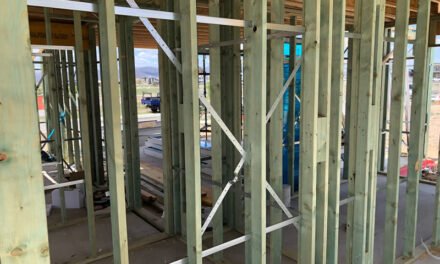A new range of programs allows designers, builders and clients to step straight from CAD to VR, allowing you to walk through projects before any real-world work begins.
One common difficulty for designers and builders is helping clients to ‘see’ the final product. Without training, clients can find plans hard to read and models are costly. Even for those with a sophisticated understanding of their build, it can be difficult to convey the impact of changes, leaving people worried about the consequences of a sensible budgeting amendment.
While rendering 3D files has gone some way in helping, new Virtual Reality (VR) technologies allow clients (and building professionals) to don a headset and get a ‘real-world’ preview of their build. Industry standard programs such as SketchUp, Revit, Rhino, ArchiCAD and FBX have a number of add-ons and compatible third-party programs that allow walk-throughs of entire designs.
Some of these are basic but effective. They use 360° stereo panorama rather than full VR to create a realistic sense of being in a space and seeing accurate proportions, while not requiring expensive headsets and killer graphics cards in your computer. Programs such as Modelo, Lumion and Iris VR’s Scope operate on systems as basic as Google Cardboard, using your smartphone rather than a costly computing system and are enough to both help designers and builders spot issues on ‘walk throughs’ and for clients and approvals-granting bodies to have a clear appreciation of the building’s size, scope and detail. The investment is around $20–100 for hardware and around $40–70 per month for the program license.
While the detail isn’t ‘real’, the experience is authentic enough for viewers to translate into a real appreciation of how they will live within the design. The ability of viewers to interact with the design is limited, but multiple views of multiple locations within the design can be loaded – relatively quickly given the smaller file sizes.
Other programs are ‘full’ VR and require more expensive, high-quality VR headsets, such as Oculus Rift or HTC’s Vive. These demand more processing power in a graphics-friendly computer, but they deliver a remarkable result, both looking true to life and allowing the viewer to move through the design and interact with it in a ‘real’ manner. Autodesk’s Revit Live provides a decent experience for Revit users, but specialist programs such as Iris VR’s Prospect and Enscape deliver smoother graphics and easier user interfaces for either editing within the program or marking up issues and corrections. Headsets cost around $600–1000 and licenses around $50 per month.
USING VR
As with VR gaming, the experience requires a bit of physical space, as the user’s actual movements are used to navigate through the virtual environment. About 2m x 2m is ideal, and – since many clients prefer privacy when using headsets – in a conference room or other quiet area is the best option. It doesn’t need to be a dedicated VR space, though, as even a full VR system can be run through a PC or laptop and headsets and hand controllers are small and wireless, making the whole system easily moveable.
Tools vary from program to program, but all start with you being able to upload data directly from your 3D design software. This information is then rendered – instantly for most of the better VR programs – so that you can virtually step into the environment and interact with it as though built.
Design aspects such as lighting, shadow paths and seasonal sunlight can also be programmed to give the user a sense of the building at different times of the day or year.
Depending on the program, the finish may be particularly high-quality and customisable, or it may have a complex ability to mark up changes within the design and save back to your design software.
Architects and builders working with VR say that it has two major advantages: internally it helps to get the whole team onto the same page, making sure that one person’s idea of a space or specified product is the same as another’s and making it easy to spot issues, such as poorly placed ducts or supports intruding into walkways. When dealing with external clients, it helps get clients and approving bodies to decision points faster, letting them see exactly what is being proposed, or how modifications will work in the real world.
Elegant Enscape
At the moment, two of the better VR programs for architects and builders reach for different ends of the market.
Enscape is optimised for display, using a graphic-designer like palette to further customise and refine the real-time rendering of data imported from Revit, SketchUp, Rhino or ArchiCAD. It does not require complex skills: the original render is already fancy and it’s exceptionally easy to make it more detailed or change elements, textures and colours using simple interface tools and drag-and-drop items from the Enscape Asset Library, which lets you add people, artefacts, trees and so on to your model.
Edits are incorporated in real time, which means that clients can watch and approve changes as you work. Fast video rendering allows for video animation and Enscape also allows you to take screenshots directly from VR, making it cheap and simple to produce high-quality marketing material.
Files can be shared with clients through the cloud via personalised links that can be opened in a standard browser where they can walk through and inspect the model without installing additional programs, or they can view a 360° stereo panorama using a device such as Google Cardboard or enter a full VR presentation, depending on need.
The Enscape forums and tutorials make detailing simple to learn, and the program is currently being used by firms around the world for everything from project acquisition to design and facility management.
Practical Prospect
Iris VR’s Prospect is the other leading option. Unlike Enscape’s ‘pretty’ graphics, it focuses more on easy collaboration between members of a design team, as well as clients and other stakeholders. Prospect loads 3D files in seconds and imports native BIM metadata into VR. While the renders are more of a classic blocky look than full graphic splendour, they allow enormous interaction and still show finishes.
Users can ‘walk’ through the model and make notes and alterations within the VR that save back to your design program. So you can use your hand controller to sketch where you would like a door shifted, or make a report from within the VR about changing the height of skirting boards or taps.
Controllers can become accurate measuring tools within the virtual world, allowing you to point at various parts of the image and read distances, alignments and more from multiple angles and scales.
Sun studies are easily carried out from within the model, both for the building itself and for neighbours affected by the structure. BIM properties can also be read within the program and checked against requirements.
Guests can join multi-user mode without an account, making it easy to invite clients, councils and builders into the process.
While neither program is a one-stop-solution, both offer exciting possibilities – as well as free trial periods for those who want a taste of what VR could do for their work.
For more, visit enscape3d.com/features/architectural-virtual-reality/ or www.irisvr.com/prospect












